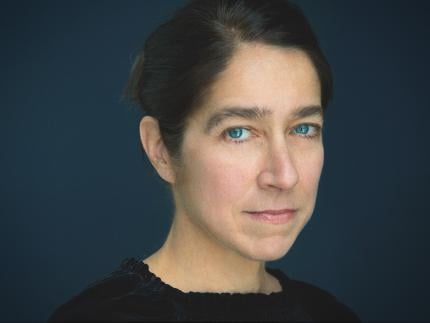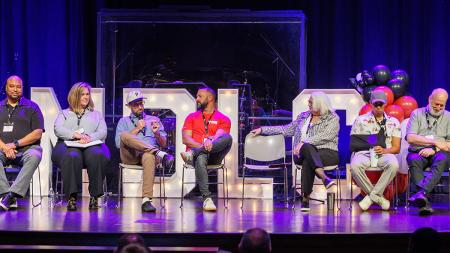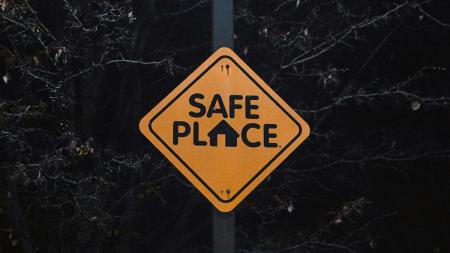Environment and Community

Kerri Arsenault began her Jan. 19 presentation at this year’s January Series with a video in which she reads the preamble to her book, Mill Town: Reckoning with What Remains. Her words describe the Androscoggin River that winds through the Maine town where she grew up, the paper mill that employed the people of the town, and the town itself, named Mexico and incorporated in 1818.
As she reads, photographs from past decades play in succession, featuring storefronts, moms and dads sitting on a porch or in their kitchen, children on bikes or at birthday parties, trucks loaded with cut logs, diner meals, sooty snow piles on parking lot edges, smoke stacks against the sky. The slides seem a bit like a photo montage commemorating a person’s life at a funeral.
In a way, the comparison is fitting; the glacier-formed bowl of land where Mexico, Maine, lies is nicknamed “Cancer Valley” as decades of pollution that can’t escape the low-lying landform take their toll on the people who live there. The town itself has been struggling economically since long before the latest recession or even the one before it.
Arsenault describes this community as the background that shaped her. “Most books or stories begin with a question,” she observed, then continued, “The nut of mine began with the most basic question of all: Who am I? She found that the book became an exploration of wider issues of industry, humankind’s relationship with the natural environment, how the decisions of leaders at various levels affect ordinary people, and the balance we need to find between employment and environment.
Arsenault’s father worked 45 years in the local paper mill, she said, as had her grandparents and great-grandparents. She described how the odors and noises of the mill were simply part of her childhood that everyone accepted because it was the livelihood of many in the community. When she left town to pursue her education, she explained, “I was a first-generation college student living out the American dream my family had worked so hard to achieve, and it was all because of paper.”
Despite the fact that much of the workforce that powered the local industrial revolution was of Acadian (French-based) descent, Arsenault realized that she had learned little about these ancestors and where they came from. Histories of the town, written by the public-relations person for the paper mill, praised town leaders and the founder of the mill but ignored the ordinary people who built and staffed it.
Arsenault noted that there was nothing in the archives about the Acadians and their history or contributions to the area’s prosperity. “We have largely commemorated the kings of resource extraction, industrialization, and colonial projects. But we avoid memorializing the environmental or social consequences of those projects, like the landscape, laborers, or Native People who have been harmed by them.” So Arsenault set out to tell the story of the people of her town and the natural environment shaped by them and shaping them.
In the river that flows through the town, framing its parks and playing fields, there are no swimmers or boaters today. “By 1970,” explained Arsenault, “the Androscoggin [River]’s dissolved oxygen level was exactly zero. Newsweeknamed it one of the ten filthiest rivers in the United States. Everything in the river died. ‘Don’t eat the fish!’ we were always told – but we couldn’t have anyway, because there were none to catch.”
She described the haze of pollution over the valley, the toxic stew in the riverbed, the rainbow foam on the river’s edge, the gray “mill snow” of ash floating up from the smokestacks and eventually down to the valley. People placed their drinking glasses upside down in their cupboard so they wouldn’t get ash in their next drink. “The pollution was as trapped as we were,” said Arsenault.
She then challenged her audience to look around their homes and to reflect on how many things within their reach or view were made of paper: magazines, books, receipts, tissues, paper towels, envelopes, labels on cans, stickers on fruit, business cards, stamps, coffee filters, etc.
Acknowledging that paper is a big part of our lives, and, for Arsenault, even part of her identity, she also noted that the manufacturing of it is a dirty process using dangerous and toxic chemicals. A byproduct of bleaching paper white is dioxins, which don’t break down completely in the environment or in our bodies – and so they continue to accumulate. Arsenault listed its effects, such as impaired fertility and sperm count, childhood development harm, damage to immune systems, neurodevelopmental issues, and more – but noted that governments and industry leaders generally don’t acknowledge the harm because it is difficult to prove the link definitively.
She then shared a story from Michigan about a 1973 accident that has affected the population of the state ever since. A worker in a chemical supply company mixed up an order, shipping and packing toxic fire retardant to a farm bureau rather than the requested livestock digestive aid. No one realized a mistake had been made. “The PBB (fire retardant) then proceeded to about 500 feed mills, where the livestock ate it up,” explained Arsenault.
“Subsequently, farmers unwittingly sold the contaminated milk and meats to processors or dairies, who sold it to grocers, who sold it to residents, who also ate it up. It was about nine months before the accident was even discovered, and a year before it was corroborated by the state – and then the public was informed. But a year was too late. Nearly the entire population of Michigan, about 9 million people at the time, had already consumed PBB-laced milk, eggs, beef, poultry, or pork.” Researchers are still studying 6,000 Michigan residents to understand the long-term effects of that PBB on the population. Remediation has cost $480 million so far, said Arsenault, and it’s not even close to being completed. Generations of Michiganders have elevated levels of toxins in their blood.
Even now, said Arsenault, most of our exposure to dioxins and other toxins comes through our food supply, especially in the fatty parts of meats like pork, lobster, beef, and other animal products like milk, butter, cheese, and eggs. “And because they bioaccumulate, the further up the food chain they go, the more toxic they become. . . . Our bodies contain enough dioxin right now to make us all sick. Even one hamburger, I learned from a dioxin expert, can be carcinogenic, organic or not.”
Maine has a reputation for being “God’s country” – a sort of natural paradise of fresh air, clean water, plentiful fish, forests and hills for hiking. But Arsenault wonders if that idealized picture ever existed outside of our minds. In a way, she said, the trauma of the reality in Maine, like the polluted Androscoggin River, unable to support life, has become the nation’s trauma. Small towns, local manufacturers, and industries dependent on natural resources feel the hardships of a changing economy, deindustrialization, and diminishing resources. At the same time, more people are seeing a need to protect what natural environments are left. There is a tension that is complex and not easy to resolve, said Arsenault.
“If they take away all our paper mill jobs, then those people don’t get to live. It is a constant negotiation. But I don’t think it should always [adversely affect] the people who are more disenfranchised; they always seem to get on the losing end of that stick. Electric cars, for instance – we’re going to have to mine that cobalt somewhere, and people are going to have to deal with that. Or where they’re manufactured, there’s going to be a lot of resource usage there. I don’t know. That’s beyond my paygrade; I’m just a writer.”
Despite the self-deprecating “just” in her conclusion, Arsenault sees writers and storytellers as a key part of the work needed to move forward in ways that protect both communities and the natural environment. She helped to found The Environmental Storytelling Studio (TESS) with a goal of helping academics tell better stories on the issue of the environment, which will in turn help more people to connect with what is at stake and make positive changes.
One example of change is the printing of her book itself: “My book uses paper that is not bleached with chlorine. We had to go to Canada to get it. There’s a bit in my book about that. It’s problematic because people don’t demand it; they don’t even know about it. So if we change our demands as a population, manufacturers will respond. But, right now, nobody’s demanding it.”
She encouraged her audience to be curious, to ask questions, to follow their interests, and to tell better stories. “I probably sounded rambly up here, but that’s how my book is too. It’s not actually rambly; it’s pretty structured, but it’s the structure of a river, which goes along a path and it does this [weaving with her hands], but it eventually leads somewhere; it ends, it dumps out into somewhere. So find your own path, whether it’s the shape of a river, or the shape of a circle; it doesn’t have to have a tidy ending, because life doesn’t really have a tidy ending either.”


